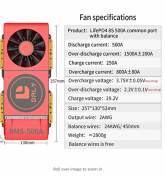CompleteSI
New Member
- Joined
- Jan 27, 2021
- Messages
- 8
Hey all!! I purchased:
(16) 280 AH LiFePO4 packs that I am running series parallel to get 24volts.
ANT 100A BMS with 300A Peak.
AIMs 6000 Watt inverter (PICOGLF6024120ULC) with 120Volt Out and 120Volt 60Amp Charger.
Victron 50 MPPT Solar Charger
800 Watts Of Renogy Solar Panels
Simarine Pico Monitor
From watching all the videos it seems like I should run everything through the ANT BMS. It is only 100Amps so there is no way it can power the inverter. I found the video where Will uses a Relay to trip a Victron Battery Protect with the inverter connected to that but found where he says not to use that anymore. Also those are only 250 Amps and my calcs say Ill be pushing 300-400 Amps. Most system diagrams I find don't seem to be as large or they don't seem to us a BMS.
Am I supposed to buy multiple BMS's and connect Parallel or is there a better alternative? Also if I don't have the inverter connected to the BMS then the Charger Just goes direct to the battery as well.
Thanks for any help, I do high end large scale Audio/Video/Automation for a living and am happy to return any help with knowledge in that area if anyone needs it.
Jon
(16) 280 AH LiFePO4 packs that I am running series parallel to get 24volts.
ANT 100A BMS with 300A Peak.
AIMs 6000 Watt inverter (PICOGLF6024120ULC) with 120Volt Out and 120Volt 60Amp Charger.
Victron 50 MPPT Solar Charger
800 Watts Of Renogy Solar Panels
Simarine Pico Monitor
From watching all the videos it seems like I should run everything through the ANT BMS. It is only 100Amps so there is no way it can power the inverter. I found the video where Will uses a Relay to trip a Victron Battery Protect with the inverter connected to that but found where he says not to use that anymore. Also those are only 250 Amps and my calcs say Ill be pushing 300-400 Amps. Most system diagrams I find don't seem to be as large or they don't seem to us a BMS.
Am I supposed to buy multiple BMS's and connect Parallel or is there a better alternative? Also if I don't have the inverter connected to the BMS then the Charger Just goes direct to the battery as well.
Thanks for any help, I do high end large scale Audio/Video/Automation for a living and am happy to return any help with knowledge in that area if anyone needs it.
Jon




